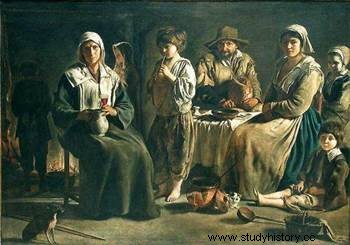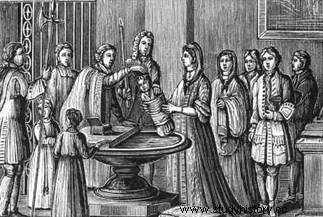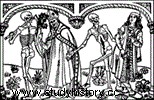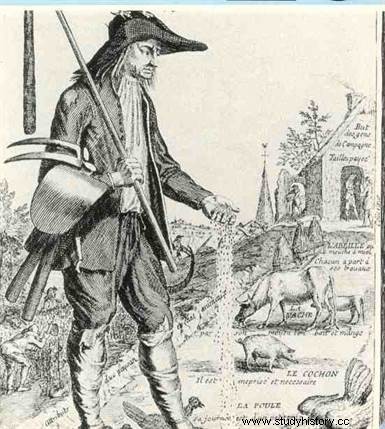 After a "sad seventeenth century" marked by numerous economic difficulties and social tensions, the eighteenth century was placed under the sign of mutations and significant evolutions. The Age of Enlightenment will see faith in the progress of reason and techniques prevail and become the workhorse of some for a general well-being. While society has been marked for several centuries by three very strong constraints (biological, food and material), certainly the 18th century illustrates a more favorable situation which will gradually break these 3 locks. This phenomenon is clearly observable at the level of the population, which is increasing, and of agriculture, which is undergoing decisive technical, structural and cultural changes.
After a "sad seventeenth century" marked by numerous economic difficulties and social tensions, the eighteenth century was placed under the sign of mutations and significant evolutions. The Age of Enlightenment will see faith in the progress of reason and techniques prevail and become the workhorse of some for a general well-being. While society has been marked for several centuries by three very strong constraints (biological, food and material), certainly the 18th century illustrates a more favorable situation which will gradually break these 3 locks. This phenomenon is clearly observable at the level of the population, which is increasing, and of agriculture, which is undergoing decisive technical, structural and cultural changes.
The population growth of the 18th century
Throughout the modern era, France appears to be the demographic heavyweight of Europe, but seems to have reached a ceiling with around 20-22 million inhabitants, placing it despite everything far ahead of its neighbours:7 million in England, 13 for Germany and Italy, 8 for Spain. At the beginning of the 18th century, population growth was general in Europe, and the French ceiling was gradually exceeded to reach 25 million in 1725, and 28 million around 1770.
This change stems above all from a significant decline in mortality, which influences natural increase. The Old Regime is characterized by a traditional demographic regime, with a high birth rate (40 per 1000), cruelly regulated by a high mortality rate (30 per 1000) especially among young children, 1 out of 2 does not reach adulthood. ("It takes 2 children to make a man"), life expectancy does not exceed 30 years, and in the end the population increases little. From the 18th century, the trend reversed slightly, mortality fell (especially that of children), the birth rate remained just as high, thus increasing the number of men.
 This decline in mortality is largely explained by an overall improvement in biological conditions. The 3 Horsemen of the Apocalypse which are epidemics, famine and war, at the origin of acute demographic crises, are less present. The crisis of the Ancien Régime is characterized by a recurring pattern:bad weather conditions lead to poor harvests which increase the price of grain. The peasant income is then essentially intended for the purchase of bread and quickly becomes insufficient in the face of the rise in prices, the paroxysm of which is during the lean season , the period preceding the harvest when grain becomes scarcer. This generates tensions, especially as some store and speculate to resell the grain when it is most expensive.
This decline in mortality is largely explained by an overall improvement in biological conditions. The 3 Horsemen of the Apocalypse which are epidemics, famine and war, at the origin of acute demographic crises, are less present. The crisis of the Ancien Régime is characterized by a recurring pattern:bad weather conditions lead to poor harvests which increase the price of grain. The peasant income is then essentially intended for the purchase of bread and quickly becomes insufficient in the face of the rise in prices, the paroxysm of which is during the lean season , the period preceding the harvest when grain becomes scarcer. This generates tensions, especially as some store and speculate to resell the grain when it is most expensive.
Times of expensive , of which contemporaries are aware, often see periods of scarcity appear. We can no longer feed ourselves, not for lack of food, but because it has become too expensive. We suffer from hunger for lack of means, and we often die after eating terrible meals:bran bread, nettle soups, viscera of cattle recovered from slaughterhouses... Emmanuel Leroy-Ladurie explains that we mainly die digestive diseases due to spoiled food. The corollary of this general weakening of organisms is the appearance of fatal epidemics sometimes decimating entire villages (plague, smallpox, etc.), wreaking havoc on the weakest (young children and old people), and mortality soars. as in Marseille in 1750 where an epidemic of plague killed 50,000 people.
A more varied and regular diet in the 18th century gradually put an end to these catastrophic episodes. The climatic situation becomes more lenient compared to the previous century (The Little Ice Age), bad harvests are rarer. The introduction of potatoes and corn (5 times more nutritious than wheat) as well as the development of market gardening allows organisms to better resist epidemics, very frequent and symptomatic deficiencies (big belly, problem of teeth...). People are better nourished and healthier overall.
Some progress in basic hygiene leads to the preservation of the health of the youngest and mothers. Often the peasants live with their animals, the manure at their door often contaminates the water of the well. Significant progress is recorded during childbirth, which was until then the prerogative of matrons with empirical knowledge, not very attentive to hygiene. Medical deliveries are emerging with a more elaborate technical environment and trained personnel. Let us cite the example of Mme de Coudrai, a midwife, who obtained a royal patent in 1756 authorizing her to teach the art of childbirth in the provinces, or the obstetrician Mauquet de la Motte who in 1715 published a Treatise on natural and unnatural childbirth . Overall mentalities with regard to the child are changing, we are more and more vigilant about fostering, which is the cause of appalling mortality in young children raised "like chickens" and left to fend for themselves most of the time.
 Wars were also less frequent in the 18th century and were localized outside the kingdom. War, of course, is the cause of many direct deaths on the battlefield. Nevertheless, its induced effects are just as devastating:destruction, fires, thefts of crops and livestock dot the path of the troops, who carry, soldiers in the lead, a whole host of diseases. The importance of peace therefore comes into play and only concerns distant territories (War of the Austrian Succession for example).
Wars were also less frequent in the 18th century and were localized outside the kingdom. War, of course, is the cause of many direct deaths on the battlefield. Nevertheless, its induced effects are just as devastating:destruction, fires, thefts of crops and livestock dot the path of the troops, who carry, soldiers in the lead, a whole host of diseases. The importance of peace therefore comes into play and only concerns distant territories (War of the Austrian Succession for example).
Thus, the improvement of biological conditions has been accompanied by a notable increase in the population, favored in this by peace.
A changing agriculture
This population growth is accompanied by an agricultural evolution which at the same time is experiencing major changes to ensure the subsistence of more and more people. Initially, there is progress in tooling. Indeed, for centuries it has changed little. It is made of wood, often "tinkered with", but adapted to the farming practices of the time which lead to mediocre yields. However, the “technical system” is changing. This notion presented by Bertrand Gille describes a coherent set of technologies constituting an identifiable stage in the evolution of techniques and of a corresponding social system. Farming tools are improving, incomes are more substantial. Thus develops the plow with more iron, a third harness horse is added to perform deeper plowing. The scythe is gradually replacing the sickle.
 Crop rotation systems, which are restrictive because they require compliance with cropping patterns and fallow periods, are changing in their turn. A two-year rotation (alternation of a cultivated plot/a fallow plot) mainly present in the South, and a three-year rotation (A plot of winter wheat/a plot of spring wheat/a plot of fallow ) we adopt a four-year rotation, also called Norfolk rotation, set up in England in the 17th century:a plot of wheat, a plot of fodder turnip, a plot of barley, a plot of clover. This rotation has the advantage of eliminating fallow land and encouraging livestock, which can graze on clover plots, a plant that provides a much more effective nitrogen supply than traditional manuring with ashes and manure.
Crop rotation systems, which are restrictive because they require compliance with cropping patterns and fallow periods, are changing in their turn. A two-year rotation (alternation of a cultivated plot/a fallow plot) mainly present in the South, and a three-year rotation (A plot of winter wheat/a plot of spring wheat/a plot of fallow ) we adopt a four-year rotation, also called Norfolk rotation, set up in England in the 17th century:a plot of wheat, a plot of fodder turnip, a plot of barley, a plot of clover. This rotation has the advantage of eliminating fallow land and encouraging livestock, which can graze on clover plots, a plant that provides a much more effective nitrogen supply than traditional manuring with ashes and manure.
This increase in production leads to better specialization of the terroirs. A distinction is made between northern and eastern France, an area of cereal monoculture over large areas, and southern and western France, with less favorable soils, where market gardening is preferred. The vineyards specialize and emphasize quality production, as in Champagne for example. Brittany, a grassy country, focuses on livestock, as does Normandy.
Finally, who says more cereals means more straw and fodder for cattle. Traditionally, livestock is the refuge resource in times of difficulty, but it is poorly selected and often lean due to frequent fodder crises. The development of livestock over the period allows better manure of the land. Some farmers can even sell straw for manure, which until then was available in small quantities, badly preserved, allowing a rather mediocre preparation of the soles. In addition, the best fodder supplies will gradually make it possible to eliminate common grazing practices and to enclose the land, enclosure , already practiced in England, which is gradually seeing the emergence of private property and facilitating the implementation of the new techniques mentioned above.
The 18th century also saw the development of new crop species, in particular potatoes and maize, both imported from America at the end of the 16th century. Corn, with a yield much higher than that of wheat, makes it possible to obtain cheap flour, less expensive than that of rye, barley or buckwheat. Initially used for cattle as fodder in order to overcome the recurring problems of cattle feed, it gradually came to supplement the diet of the poorest. Ditto for potatoes, 5 times more nutritious than wheat.
Undeniably, agriculture is on the rise, as shown by a fairly abundant literature dealing with agronomy. Under the impetus of the Enlightenment and the thinking of the physiocrats around 1750, whose leader François Quesnay highlights the importance of agriculture, the only branch deemed to be productive in the economy. The physiocrats have a great influence among the aristocratic elite and the big landowners. We experiment with new plants to grow, new rotation systems, etc. For example, Lavoisier, chemist, academician and general farmer, is very involved in this approach.
Clear progress therefore, by the conjunction of various factors (tools, new cultures, physiocrats...) which allow the agricultural sector, which represented ¾ of the physical product in the 18th century, to experience a better yield, better production, and support population growth.
The life of peasants in the 18th century
The demographic progress recorded is accompanied by stark contrasts. First, mortality. Even if it has dropped, infant mortality remains appalling because progress is slow, hygiene remains sketchy, the collective habitat conducive to filth, and the proximity of livestock still spreads disease. Literacy is making progress, as is education in general. But despite everything, ignorance remains quite widespread, especially in the countryside. A priest believes that in his parish in Brittany, a significant proportion of deaths is attributable to the ignorance of matrons. Added to this are the weight of habits and superstition, already denounced in his time by Erasmus in the 16th century. Contemporaries, generally aware of this state of popular beliefs, are well aware that it is a brake. Farmers bring their cattle to church for a blessing to protect their livestock from rabies...
Poverty remains the daily life of the majority of the population, mostly peasants, 80% rural. The crises, even if they are on the decline, are nonetheless still very present and the people remain subject to diseases (the plague of Marseilles in 1750) or to climatic hazards (the Great Hyver of 1709) and each crisis is accompanied by phenomena of wandering of people fleeing misery to seek a hypothetical better fate elsewhere. Poverty leads to heavy indebtedness to pay taxes, seeds, equipment, often well beyond the value of the property owned. Laurence Fontaine evokes the case of a laundress from Lyon who died leaving a legacy of 150 pounds and a debt of 2000 pounds, and this case is not exceptional.
 Furthermore, population growth leads to an increasing number of mouths to feed, which to some extent may stimulate agricultural production, but the fact remains that this influx of population leads to a fragmentation of land and estates, reinforcing peasant precariousness, especially as the rent increases and sees the owners who hold the peasants at their mercy grow richer .
Furthermore, population growth leads to an increasing number of mouths to feed, which to some extent may stimulate agricultural production, but the fact remains that this influx of population leads to a fragmentation of land and estates, reinforcing peasant precariousness, especially as the rent increases and sees the owners who hold the peasants at their mercy grow richer .
An agriculture that remains traditional
From an agricultural point of view, certainly there is progress, but we cannot speak of an agricultural revolution, far from it. Progress is diffuse and varies by province. It is very often an accumulation of small innovations which in the end constitute progress, but very localized. The use of iron remains an exception in this civilization of wood, and the family base of farms is not conducive to progress because knowledge is transmitted empirically.
The specialization of land leads in the North (essentially focused on cereal monoculture) to great fragility in the event of a bad harvest, a problem encountered much less by farmers in the South where the climate and the soils allow a more diverse culture, even if bread remains the basis of the food bowl.
Strong resistance is displayed in relation to new crops. Despite the many advantages of maize and potato, these remain mainly dedicated to cattle feed and are only used as supplementary food in the event of a hard blow. These plants are struggling to establish themselves, despite good provisions for maize in the South. This resistance is partly explained by the fact that a small farmer does not want to take the risk of “missing” a harvest of a plant that he has never grown before, which would spell disaster for him. For the moment, we can still speak of imperialism of the bledz , and even if efforts are made, they remain marginal and concern only a minority of large owners. Fallow still represented 27% of the cultivated area in France in 1840.
Finally, the enclosure system widely used in England from the 17th century, is perceived as an attack on collective farms. By enclosing the fields and eliminating common grazing, a whole section of the peasantry is deprived of its resources.
Population growth is therefore the result of efforts in terms of hygiene, but progress is slow and varies depending on whether one is in the city or in the countryside. As for agriculture, it still remains largely traditional due to numerous resistances to novelties.
Sources
- Arthur Young, Travel to France. Text, 2009
- Joël Cornette, Absolutism and Enlightenment. Hatchet Sup. 2008.
- Arlette Jouanna, Renaissance France. Tempus, 2009.
